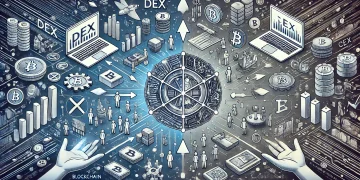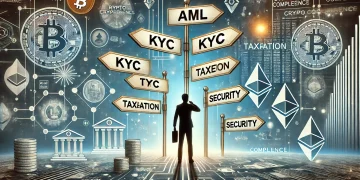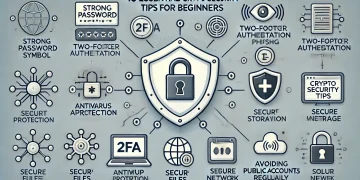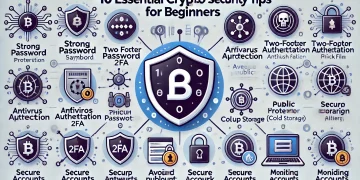Table of Contents
- Introduction
- Understanding DeFi (Decentralized Finance)
- Exploring NFTs (Non-Fungible Tokens)
- The Convergence of DeFi and NFTs
- Challenges and Risks
- Future Outlook
- Getting Started with DeFi and NFTs
- Conclusion
Introduction
The world of blockchain technology has given rise to two groundbreaking innovations that are reshaping the landscape of finance, art, and digital ownership: Decentralized Finance (DeFi) and Non-Fungible Tokens (NFTs). These technologies are not only challenging traditional systems but also opening up new possibilities for financial inclusion, creative expression, and digital asset management.
In this comprehensive guide, we’ll delve into the intricacies of DeFi and NFTs, explore the latest trends shaping these spaces, and uncover the myriad opportunities they present. Whether you’re a curious newcomer, an investor looking for the next big thing, or a creator seeking new ways to monetize your work, this article will provide you with valuable insights into these exciting and rapidly evolving fields.
Understanding DeFi (Decentralized Finance)
What is DeFi?
Decentralized Finance, commonly known as DeFi, refers to a ecosystem of financial applications built on blockchain networks, primarily Ethereum. DeFi aims to recreate and improve upon traditional financial systems such as banking, lending, and trading, but in a decentralized manner, without the need for intermediaries like banks or other financial institutions.
Key characteristics of DeFi include:
- Decentralization: DeFi applications run on decentralized networks, meaning they’re not controlled by any single entity.
- Open-source: Most DeFi protocols have their code publicly available, allowing for transparency and community-driven development.
- Permissionless: Anyone with an internet connection can access DeFi services, regardless of their location or financial status.
- Interoperability: DeFi applications can often interact with each other, creating complex financial products and services.
- Programmable: Smart contracts enable the creation of programmable money and automated financial services.
Key Components of DeFi
The DeFi ecosystem consists of several key components:
- Decentralized Exchanges (DEXs): Platforms like Uniswap and SushiSwap allow users to trade cryptocurrencies directly from their wallets without intermediaries.
- Lending and Borrowing Platforms: Protocols such as Aave and Compound enable users to lend their crypto assets to earn interest or borrow assets by providing collateral.
- Stablecoins: Cryptocurrencies designed to maintain a stable value, often pegged to a fiat currency. Examples include DAI and USDC.
- Yield Farming: The practice of staking or lending crypto assets to generate high returns.
- Liquidity Mining: A subset of yield farming where protocols distribute their native tokens to users who provide liquidity.
- Synthetic Assets: Tokenized derivatives that provide exposure to real-world assets on the blockchain.
- Insurance: Decentralized insurance protocols that protect users against smart contract failures or hacks.
Latest Trends in DeFi
The DeFi space is constantly evolving. Here are some of the latest trends:
- Cross-chain DeFi: Interoperability solutions allowing DeFi applications to work across different blockchain networks.
- Layer 2 Solutions: Scaling solutions like Optimistic Rollups and zk-Rollups that aim to increase transaction speed and reduce costs on Ethereum.
- Governance Tokens: Tokens that give holders voting rights in protocol decisions, fostering decentralized governance.
- Algorithmic Stablecoins: Stablecoins that maintain their peg through algorithmic methods rather than collateralization.
- Real-World Asset Tokenization: Bringing real-world assets like real estate and stocks onto the blockchain.
- DeFi 2.0: New protocols focusing on capital efficiency and sustainable yield generation.
- Decentralized Identity Solutions: Integrating decentralized identity systems to enhance security and compliance in DeFi.
Opportunities in DeFi
DeFi presents numerous opportunities for various stakeholders:
- For Users: Access to a wide range of financial services without traditional barriers, potentially higher yields on investments, and greater control over assets.
- For Developers: The ability to create innovative financial products and services, participate in open-source development, and potentially earn rewards through token incentives.
- For Investors: New investment opportunities, portfolio diversification, and the potential for high returns (albeit with high risk).
- For Traditional Finance: Opportunities to integrate DeFi technologies to improve efficiency and offer new services to clients.
- For the Unbanked: Access to financial services for those excluded from traditional banking systems.
Exploring NFTs (Non-Fungible Tokens)
What are NFTs?
Non-Fungible Tokens (NFTs) are unique digital assets that represent ownership of a specific item or piece of content on the blockchain. Unlike cryptocurrencies such as Bitcoin or Ethereum, which are fungible (interchangeable), each NFT is unique and cannot be replicated or divided.
Key characteristics of NFTs include:
- Uniqueness: Each NFT has distinct properties that make it one-of-a-kind.
- Indivisibility: NFTs cannot be divided into smaller units.
- Provable Scarcity: The blockchain provides a verifiable record of an NFT’s rarity.
- Programmability: NFTs can include smart contracts that define their behavior or grant specific rights to the owner.
How NFTs Work
NFTs are typically created, or “minted,” on blockchain platforms that support smart contracts, with Ethereum being the most popular. The process involves:
- Creation: The digital asset is created and its metadata is defined.
- Minting: The asset is registered on the blockchain, creating a unique token.
- Storage: The NFT’s metadata and ownership information are stored on the blockchain.
- Transfer: NFTs can be bought, sold, or transferred between wallet addresses.
Latest Trends in NFTs
The NFT space is rapidly evolving. Here are some of the latest trends:
- Metaverse Integration: NFTs are being used to represent virtual real estate, avatars, and items in virtual worlds.
- Fractional NFTs: Allowing partial ownership of high-value NFTs to increase accessibility.
- Dynamic NFTs: NFTs that can change based on external conditions or interactions.
- Music NFTs: Artists releasing music as NFTs, offering unique experiences and royalty structures.
- Gaming NFTs: In-game items represented as NFTs, allowing for true ownership and cross-game compatibility.
- NFT-Fi: The intersection of NFTs and DeFi, allowing NFTs to be used as collateral for loans.
- Social Tokens: NFTs representing social currency or access to exclusive communities.
- Environmental Concerns: A shift towards more energy-efficient NFT minting and trading processes.
Opportunities in NFTs
NFTs present various opportunities across different sectors:
- For Artists and Creators: New ways to monetize digital art, music, and other creative works, with the potential for ongoing royalties.
- For Collectors: The ability to own verifiably unique digital assets and potentially profit from their appreciation in value.
- For Gamers: True ownership of in-game assets, with the ability to trade or sell them outside of the game ecosystem.
- For Brands: New avenues for customer engagement, loyalty programs, and digital merchandising.
- For the Music Industry: Novel ways to distribute music and connect with fans, potentially disrupting traditional royalty models.
- For Real Estate: Tokenization of property ownership, enabling fractional ownership and more liquid real estate markets.
- For Education: Verifiable credentials and certificates as NFTs, enhancing the legitimacy of online education.
The Convergence of DeFi and NFTs
One of the most exciting developments in the blockchain space is the increasing convergence of DeFi and NFTs. This intersection, sometimes referred to as NFT-Fi, is creating new possibilities:
- NFT-Collateralized Loans: Using NFTs as collateral for loans in DeFi protocols.
- NFT Fractionalization: Breaking down high-value NFTs into fungible tokens that can be traded on DEXs.
- NFT Yield Farming: Staking NFTs to earn yields in DeFi protocols.
- Liquidity Provision for NFTs: Creating more liquid markets for NFT trading.
- NFT Derivatives: Creating financial products based on NFT market performance.
This convergence is blurring the lines between different types of digital assets and creating new financial instruments and opportunities.
Challenges and Risks
While DeFi and NFTs offer exciting opportunities, they also come with significant challenges and risks:
- Regulatory Uncertainty: The regulatory status of many DeFi applications and NFTs remains unclear in many jurisdictions.
- Security Risks: Smart contract vulnerabilities can lead to hacks and loss of funds.
- Scalability Issues: High transaction fees and network congestion, particularly on the Ethereum network.
- Market Volatility: The value of cryptocurrencies, DeFi tokens, and NFTs can be highly volatile.
- Environmental Concerns: The energy consumption of some blockchain networks has raised environmental concerns.
- Complexity: The learning curve for participating in DeFi and NFT markets can be steep for newcomers.
- Fraud and Scams: The nascent nature of these technologies has attracted bad actors looking to exploit uninformed users.
Future Outlook
The future of DeFi and NFTs is likely to be shaped by several factors:
- Technological Advancements: Improvements in blockchain scalability and interoperability will likely drive further innovation.
- Regulatory Developments: Clearer regulations could provide more certainty and potentially wider adoption.
- Institutional Adoption: Increased interest from traditional financial institutions could bring more liquidity and stability.
- Mainstream Adoption: Simplified user interfaces and better education could make these technologies more accessible to the general public.
- Integration with Traditional Systems: We may see more integration between DeFi, NFTs, and traditional financial and creative industries.
- Sustainability Focus: Addressing environmental concerns will likely be a key focus for future development.
Getting Started with DeFi and NFTs
If you’re interested in exploring DeFi and NFTs, here are some steps to get started:
- Educate Yourself: Continue learning about these technologies, their potential, and their risks.
- Set Up a Wallet: Get a non-custodial wallet that supports DeFi applications and NFTs, such as MetaMask.
- Acquire Some Cryptocurrency: You’ll need some cryptocurrency, typically Ethereum, to interact with most DeFi applications and NFT marketplaces.
- Start Small: Begin with small amounts to familiarize yourself with the processes and risks involved.
- Explore DeFi Applications: Start with well-established protocols and gradually explore other applications as you gain confidence.
- Explore NFT Marketplaces: Platforms like OpenSea, Rarible, and Nifty Gateway are good places to start exploring NFTs.
- Stay Informed: Keep up with the latest developments in the DeFi and NFT spaces through reputable news sources and community forums.
- Practice Security: Use strong passwords, enable two-factor authentication, and be cautious of phishing attempts.
Remember, both DeFi and NFTs involve financial risk, so never invest more than you can afford to lose.
Conclusion
DeFi and NFTs represent two of the most innovative and disruptive applications of blockchain technology. They are reshaping our understanding of finance, ownership, and digital assets, opening up new possibilities for financial inclusion, creative expression, and digital interactions.
As these technologies continue to evolve, they offer exciting opportunities for users, creators, investors, and developers alike. However, it’s crucial to approach them with a balanced perspective, understanding both their potential and their risks.
Whether you’re looking to participate in new financial systems, explore digital art ownership, or simply stay informed about cutting-edge technology, DeFi and NFTs are fields worth watching. As we move further into the digital age, these technologies are likely to play an increasingly important role in shaping our financial and digital landscapes.
The world of DeFi and NFTs is dynamic and fast-paced, with new developments emerging constantly. By staying informed, approaching with caution, and engaging thoughtfully, you can navigate this exciting new frontier and potentially benefit from the opportunities it presents.






























